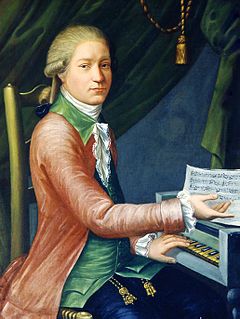Pygmalion or Pigmalion may refer to:
Orfeo ed Euridice is an opera composed by Christoph Willibald Gluck, based on the myth of Orpheus and set to a libretto by Ranieri de' Calzabigi. It belongs to the genre of the azione teatrale, meaning an opera on a mythological subject with choruses and dancing. The piece was first performed at the Burgtheater in Vienna on 5 October 1762, in the presence of Empress Maria Theresa. Orfeo ed Euridice is the first of Gluck's "reform" operas, in which he attempted to replace the abstruse plots and overly complex music of opera seria with a "noble simplicity" in both the music and the drama.

L'Orfeo, sometimes called La favola d'Orfeo[la ˈfaːvola dorˈfɛːo], is a late Renaissance/early Baroque favola in musica, or opera, by Claudio Monteverdi, with a libretto by Alessandro Striggio. It is based on the Greek legend of Orpheus, and tells the story of his descent to Hades and his fruitless attempt to bring his dead bride Eurydice back to the living world. It was written in 1607 for a court performance during the annual Carnival at Mantua. While Jacopo Peri's Dafne is generally recognised as the first work in the opera genre, and the earliest surviving opera is Peri's Euridice, L'Orfeo is the earliest that is still regularly performed.

Galatea is a name popularly applied to the statue carved of ivory by Pygmalion of Cyprus, which then came to life in Greek mythology. In modern English, the name usually alludes to that story.

Euridice is an opera by Jacopo Peri, with additional music by Giulio Caccini. It is the earliest surviving opera, Peri's earlier Dafne being lost. The libretto by Ottavio Rinuccini is based on books X and XI of Ovid's Metamorphoses which recount the story of the legendary musician Orpheus and his wife Euridice.

Pygmalion is a legendary figure of Cyprus in Greek mythology who was a king and a sculptor. Though Pygmalion is the Greek version of the Phoenician royal name Pumayyaton, he is most familiar from Ovid's narrative poem Metamorphoses, in which Pygmalion was a sculptor who fell in love with a statue he had carved.

Yevstigney Ipat'yevich Fomin was a Russian opera composer of the 18th century.
Gaetano Guadagni was an Italian mezzo-soprano castrato singer, most famous for singing the role of Orpheus at the premiere of Gluck's opera Orfeo ed Euridice in 1762.
Gasparo Angiolini, real name Domenico Maria Gasparo, son of Francesco Angiolini and Maria Maddalena Torzi, was an Italian dancer and choreographer, and composer. He was born in Florence and died in Milan.

The ancient legend of Orpheus and Eurydice concerns the fateful love of Orpheus of Thrace for the beautiful Eurydice. Orpheus was the son of Apollo and the muse Calliope. It may be a late addition to the Orpheus myths, as the latter cult-title suggests those attached to Persephone. It may have been derived from a legend in which Orpheus travels to Tartarus and charms the goddess Hecate.

Pygmalion is a monodrama in one act by composer Georg Benda with a German libretto by Friedrich Wilhelm Gotter. The opera's first performance was at the Ekhof Theatre, the court theatre in Gotha, on 20 September 1779. Pygmalion was the fourth of the five theatrical collaborations of Benda and Gotter. Gotter based his text on Jean-Jacques Rousseau's 1762 play Pygmalion. Benda's melodrama is unusual as it has three characters but only one spoken role. Two of the parts are silently acted on stage.
L'Orfeo (Orpheus) is an opera in three acts, a prologue and an epilogue by the Italian composer Luigi Rossi. The libretto, by Francesco Buti, is based on the myth of Orpheus and Eurydice. Orfeo premiered at the Théâtre du Palais-Royal in Paris on 2 March 1647. It was one of the earliest operas to be staged in France.
Chaconne is a ballet made by New York City Ballet co-founder and ballet master George Balanchine to ballet music from Gluck's Orfeo ed Euridice. The premiere took place Wednesday, 22 January 1976 at the New York State Theater, Lincoln Center, with lighting by Ronald Bates; Robert Irving conducted. Chaconne was danced in practice clothes at its premiere; Karinska's costumes were added in the spring season.

Orpheus is a legendary musician, poet, and prophet in ancient Greek religion.

In Greek mythology, Eurydice or Eurydike was the wife of Orpheus, who tried to bring her back from the dead with his enchanting music.
Horace Coignet was a French amateur violinist, singer and composer. He was active in Lyons as a pattern-designer and dealer in embroidered goods, as an official clerk and as musical director of the city from 1794. He became the music instructor to the Duchesse d'Aumont in Paris, and later returned to Lyons where he served on the directorial board of the conservatory. He was known as a gifted violinist, and composed harpsichord pieces, romances, a set of Trois duos concertants de violon et fugues, a revolutionary hymn for the Rousseau celebration at Lyons and some theatrical music His most notable work the music for Jean-Jacques Rousseau's 1762 short play Pygmalion, first performed in Lyon in 1770 was a success and soon became known throughout Europe.
Pygmalion; or, The Statue Fair is a play by William Brough that was advertised as a musical burlesque. It was first produced in 1867, and revived in March 1872.
Le feste d'Apollo is an operatic work by Christoph Willibald von Gluck, first performed at the Teatrino della Corte, Parma, Italy, on 24 August 1769 for the wedding celebrations of Ferdinand, Duke of Parma and Archduchess Maria Amalia of Austria.

The following discography for Gluck's opera Orfeo ed Euridice is mainly based on the research of Giuseppe Rossi, which appeared in the programme notes to the performance of the work at the 70th Maggio Musicale Fiorentino in 2007, under the title "Discografia – Christoph Willibald Gluck – Orfeo ed Euridice ". Rossi's data has been checked against the sources referenced in the notes.









